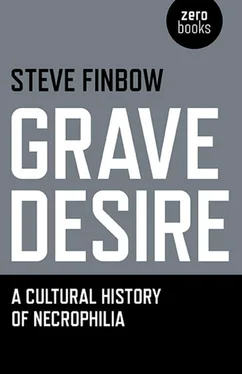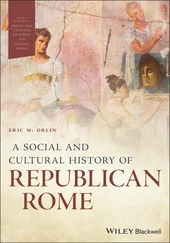Steve Finbow - Grave Desire - A Cultural History of Necrophilia
Здесь есть возможность читать онлайн «Steve Finbow - Grave Desire - A Cultural History of Necrophilia» весь текст электронной книги совершенно бесплатно (целиком полную версию без сокращений). В некоторых случаях можно слушать аудио, скачать через торрент в формате fb2 и присутствует краткое содержание. Город: Winchester, Год выпуска: 2014, ISBN: 2014, Издательство: Zero Books, Жанр: История, Психология, sci_social_studies, на английском языке. Описание произведения, (предисловие) а так же отзывы посетителей доступны на портале библиотеки ЛибКат.
- Название:Grave Desire: A Cultural History of Necrophilia
- Автор:
- Издательство:Zero Books
- Жанр:
- Год:2014
- Город:Winchester
- ISBN:978-1-78279-342-7
- Рейтинг книги:3 / 5. Голосов: 1
-
Избранное:Добавить в избранное
- Отзывы:
-
Ваша оценка:
- 60
- 1
- 2
- 3
- 4
- 5
Grave Desire: A Cultural History of Necrophilia: краткое содержание, описание и аннотация
Предлагаем к чтению аннотацию, описание, краткое содержание или предисловие (зависит от того, что написал сам автор книги «Grave Desire: A Cultural History of Necrophilia»). Если вы не нашли необходимую информацию о книге — напишите в комментариях, мы постараемся отыскать её.
Throughout the book, examples from the works of Herodotus, the Metaphysical poets, the Marquis de Sade, Cormac McCarthy, Poppie Z. Brite, Jorg Buttgereit and more are used for illustration.
Grave Desire: A Cultural History of Necrophilia — читать онлайн бесплатно полную книгу (весь текст) целиком
Ниже представлен текст книги, разбитый по страницам. Система сохранения места последней прочитанной страницы, позволяет с удобством читать онлайн бесплатно книгу «Grave Desire: A Cultural History of Necrophilia», без необходимости каждый раз заново искать на чём Вы остановились. Поставьте закладку, и сможете в любой момент перейти на страницу, на которой закончили чтение.
Интервал:
Закладка:
‘The head, even the human head, is not necessarily a face. The face is produced only when the head ceases to be a part of the body, when it ceases to be coded by the body, when it ceases to have a multidimensional, polyvocal corporeal code—when the body, head included, has been decoded and has to be overcoded by something we shall call the Face. This amounts to saying that the head, all the volume-cavity elements of the head, have to be facialized. What accomplishes this is the screen with holes, the white wall/black hole, the abstract machine producing faciality. But the operation does not end there: if the head and its elements are facialized, the entire body also can be facialized, comes to be facialized as part of an inevitable process. When the mouth and nose, but first the eyes, become a holey surface, all the other volumes and cavities of the body follow. An operation worthy of Doctor Moreau: horrible and magnificent. Hand, breast, stomach, penis and vagina, thigh, leg and foot, all come to be facialized. Fetishism, erotomania, etc., are inseparable from these processes of facialization. It is not at all a question of taking a part of the body and making it resemble a face, or making a dream-face dance in a cloud. No anthropomorphism here. Facialization operates not by resemblance but by an order of reasons. It is a much more unconscious and machinic operation that draws the entire body across the holey surface, and in which the role of the face is not as a model or image, but as an overcoding of all of the decoded parts. Everything remains sexual; there is no sublimation, but there are new coordinates.’ [45] A Thousand Plateaus: Capitalism and Schizophrenia, p. 129.
Hans Bellmer meets J.G. Ballard meets Sergeant Bertrand in a re-assembled body that resembles the human but is a fetishization of the anthropomorphic, a metonymous construction of the living dead.
Did Sergeant Bertrand’s mother die when he was a young child and her inanimate body become phenomena replacing the primary object? Was he exposed to her body, the dead body becoming the object, the fetish of his awakening sexuality? A mourning room filled with aunts, fussing around the body, powdering its face, making it beautiful? But not all who see dead mothers turn into Norman Bates, turn into Sergeant Bertrand. One could argue that the dead body, the object of the necrophile’s sexual obsession, is an inanimate, nonliving possession, used to achieve sexual fulfilment, no different from a shoe. Why, then, is the event of necrophilia so abhorrent and how did the good soldier Bertrand become the precursor of those twentieth-century ghouls Ted Bundy and Jeffrey Dahmer? ‘This is why Oedipus gathers up everything, everything is found again in Oedipus, which is indeed the result of universal history, but in the singular sense in which capital is already the result. Fetishes, idols, images, and simulacra—here we have the whole series: territorial fetishes, despotic idols or symbols, then everything is recapitulated in the images of capitalism, which shapes and reduces them to Oedipal simulacrum.’ [46] Anti-Oedipus, p. 267.
Is necrophilia a fetish? Or is it a mania? What is it that drives a man to violate a dead body in order to achieve (for him) the ultimate orgasm? Is it any more shocking than other forms of paraphilia? In Necrophilia: Forensic and Medico-Legal Aspects, Anil Aggrawal calls for a new classification of necrophilia, critiquing previous classifications and setting out ten separate classes of necrophiliac behaviour. In 1886, Krafft-Ebing classified necrophiles in two categories—ones who used corpses for sexual purposes—so passive necrophiles, and active necrophiles who killed out of desire for sex with a dead body and mutilated them in the process. Erich Wulffen added a further category in 1910, in addition to lust murder (necrosadism), and having sex with an already dead body (necrostuprum), he added necrophagy involving consumption of dead flesh. In 1931, Ernest Jones argued that passive necrophilia—sex with an already dead body—fell into two categories: sex with a loved one (partner, relative) and sex with a non-loved one’s corpse—both involving extreme forms of masochism and sadism. Magnus Hirschfield claimed something similar to Krafft-Ebing, stating that necrophiles either sexually abused corpses or that they murdered in order to destroy the person and then further humiliate the body through sex. Thirty years later, J. Rosman and P. Resnick Rosman concluded that necrophiles fell into two groups—genuine necrophiles and pseudonecrophiles. Genuine necrophiles are sexually attracted to corpses and include the three subgroups of necrophiliac homicides, regular necrophiles who use bodies for sex, and a group who use necrophiliac fantasy as a sexual release without having contact with an actual corpse. Aggrawal suggest an extension of these classifications due to the increase in information on necrophiles. [47] See: Anil Aggrawal, Necrophilia: Forensic and Medico-Legal Aspects (Boca Raton, 2011). All quotes from early case studies are taken from this excellent study.
Class I—‘role players,’ such as the Austrian incestuous rapist Josef Fritzl, who do not desire sex with a corpse but prefer their sexual partner (however coerced) to be utterly passive, feigning death. Class II—‘romantic necrophiles’ who keep a body or body part of a loved one in order to continue having sex with their partner. Class III—‘necrophiliac fantasizers’—those who create sexual fantasies involving a corpse, masturbate in cemeteries, etc. Class IV—‘tactile necrophiles’ who like to touch corpses and masturbate over them. ‘Fetishistic necrophiles’ make up Class V—use body parts as sexual fetishes. Class VI involves ‘necro-mutilomaniacs’ who achieve sexual orgasm through mutilation of corpses—Sergeant Bertrand was a necromutilomaniac. Morturay attendants, gravediggers, medical workers and alike fall into Class VII—‘Opportunistic necrophiles’—those who have sex with living partners but when able will take the opportunity to fuck dead bodies. Class VIII—‘regular necrophiles’ who have sex with dead bodies, haunters of graveyards, morgues, these ‘regular necrophiles’ are able to have sex with the living and will not kill to satiate their lust; that falls to those in Class IX, the ‘homicidal necrophiles’ who murder and mutilate in order to have sex with a dead body or as a means of controlling that body (see Jeffrey Dahmer and Dennis Nilsen) but can also have sex with a living person. Finally, Class X necrophiles who can only be sexually stimulated by having intercourse (orally, anally, vaginally, or in any created orifice) with a dead body.
Although there are crossovers and anomalies in Aggrawal’s studies, this new classification extends Krafft-Ebing’s basic dual categorization and provides a basis for an investigation into the different forms of necrophilia. Aggrawal’s legal and medical research also looks into the aetiology and epidemiology of necrophilia, which complements the categories and sexual studies. [48] See: Chapter 3, Necrophilia: Forensic and Medico-Legal Aspects.
The aetiology of necrophilia is murky, confusing, and rests on theoretical assumptions and propositional analysis. Although Havelock Ellis [49] See: Havelock Ellis, Studies in the Psychology of Sex, Volume V: Erotic Symbolism, The Mechanism of Detumescence, The Psychic State in Pregnancy, (Philadelphia, 1923).
suggested a congenital defect as a basis for necrophilia in the case of a gravedigger who suffered from anosmia (inability to perceive odours) and whose mother was highly sexed. Ellis argues that because the man thought the act of necrophilia normal—and that he lacked the sense of smell—then his acts were caused by congenital defects, blaming the man’s mother, her sexual proclivities, and lack of intelligence for her son’s necrophilia—if this categorization were applied to the general populace, it would mean necrophilia was more prevalent than studies suggest. Brill [50] See: A. A. Brill, Necrophilia—Part I. J. Criminal Psychopathology, 1941; 2 (4) pp. 433–443.
argues that heredity could play a part in the emergence of necrophiliac tendencies, documenting a man whose aggressive and criminalistic father and psychologically feeble mother caused him to be effeminate, this, Brill claims, mixed with an oral fixation resulted in necrophiliac acts. ‘But Christie had frightened her. Although Mrs Christie wasn’t there, he had done some strange intimate things, asked her to open her mouth so he could look down her throat with a mirror on the end of a rod, and asked her to lift her skirt up to mid-thigh level.’ [51] Ruth Rendell, Thirteen Steps Down (London, 2005), p. 133.
Case studies cite trauma as a potential cause, head injuries causing a shift in sexuality and attendant aggression causing a desire for sex with dead bodies—see below the cases of John Reginald Halliday Christie and Fred West for possible trauma- induced aetiology. In Christie’s case, sexual inadequacy may also have been a cause—Christie had a very small penis and felt inadequate when confronted by living women, preferring them to either play dead or be dead before he had sex with them. Alcoholism and drug use may be contributing factors, see below Jeffrey Dahmer and Dennis Nilsen as examples of homosexual necrophiles who used alcohol and drugs to not only embolden themselves but to incapacitate their victims. ‘His body went rigid. He grabbed my jumper with both hands, shouting inarticulately. Hot bright pain shot through my chest as Dr Drummond’s incision came open again. I sliced at Sam’s fingers, felt the blade scrape across bone. He made an awful sound halfway between a sob and a scream. I imagined him trying to comprehend what was happening through his alcoholic haze, and I cursed myself for drinking enough to make me clumsy. I’d meant to send him off quick and clean. This was no better than butchery.’ [52] Poppy Z. Brite, Exquisite Corpse (London, 1996), p. 66.
Temporal lobe anomalies—severe headaches, hallucinations, sometimes caused by alcohol and drugs—are evident in paraphilias such as necrophilia. Poe’s use of opium may have fuelled his necrophiliac stories: ‘And again I sunk into visions of Ligeia—and again, (what marvel that I shudder while I write,) again there reached my ears a low sob from the region of the ebony bed. But why shall I minutely detail the unspeakable horrors of that night? Why shall I pause to relate how, time after time, until near the period of the gray dawn, this hideous drama of revivification was repeated; how each terrific relapse was only into a sterner and apparently more irredeemable death; how each agony wore the aspect of a struggle with some invisible foe; and how each struggle was succeeded by I know not what of wild change in the personal appearance of the corpse?’ [53] Edgar Allan Poe, Poetry and Tales (New York, 1984) p. 276.
Aggrawal cites harsh treatment, excessive criticism, and childhood neglect as contributory factors; and Ted Bundy, Fred West, and other necrophiles suffered from one or all of these, yet so have a large number of children. Fred West also suffered sexual abuse in childhood, another possible cause of necrophiliac tendencies. Some or all of these aetiologies may combine to create a personality disorder [54] See: Erich Fromm, The Anatomy of Human Destructiveness (New York, 1973).
that results in a desire for the dead; but, I would argue, in the majority of cases does not. Theories as to the cause of necrophilia range from congenital deficiency, feeble-mindedness, mental weakness, to neo-Freudian analysis of childhood, dreams, and language, viewing necrophilia as a revenge sexual act on the displaced and transferred body of the mother—see the later analysis of Jerry Brudos.
Интервал:
Закладка:
Похожие книги на «Grave Desire: A Cultural History of Necrophilia»
Представляем Вашему вниманию похожие книги на «Grave Desire: A Cultural History of Necrophilia» списком для выбора. Мы отобрали схожую по названию и смыслу литературу в надежде предоставить читателям больше вариантов отыскать новые, интересные, ещё непрочитанные произведения.
Обсуждение, отзывы о книге «Grave Desire: A Cultural History of Necrophilia» и просто собственные мнения читателей. Оставьте ваши комментарии, напишите, что Вы думаете о произведении, его смысле или главных героях. Укажите что конкретно понравилось, а что нет, и почему Вы так считаете.












